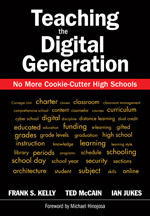Teaching the Digital Generation
no information available
This might well be THE contemporary manual for effective education reform In a world where the future is now, schools are falling behind It is a lag we can nlonger afford —Sean M Nosek, Principal Westview Secondary School, Maple Ridge, BC, Canada This is the most important book about high schools since Breaking Ranks for school facilities planners —David E Anstrand, Principal, Education Environment Planning Consultants Board Member, Council of Educational Facility Planners International Discover options for instruction and school design that reflect the needs of 21st-century students! Preparing students tmeet the demands of a constantly changing, technology-driven environment presents todays educators with unique challenges This innovative resource demonstrates how traditional, industrial-type high schools have become outdated and helps school leaders plan facilities and curriculum in ways that benefit students academic development and performance Teaching the Digital Generation examines how educators can address the learning needs of secondary students immersed in a digital world by designing and implementing new instructional models and technology infrastructure The authors explore ten alternative high school models that address 21st-century skills such as critical thinking, problem solving, and digital literacy, and pose five critical considerations: What should instruction and learning look like in a 21st-century school? How can technology foster this kind of learning? What noninstructional components are required? How can time be used differently tsupport our vision? How can new facility design turn this vision intreality? Incorporating issues of facility design with curriculum and instructional planning, the authors offer educational leaders a new vision for schools ... Read more Read less











